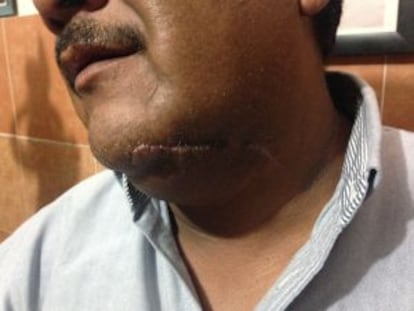Is a female serial killer behind mystery attacks in a Mexico City suburb?
Survivors claim woman approaches victims from behind and slashes their throats Residents believe attacker could be a transvestite or a grieving mother who lost a son


She is thin but strong; well-dressed and between the ages of 20 and 25; has dark skin; and always attacks her victims with a knife.
They call her “La Degolladora” (the throat-slitter).
Between September 14 and 18, she killed two women and has seriously wounded five more people. Witnesses say she approaches her victims from behind and holds them with her right arm, while slashing their neck with a knife in her left hand. The attacks have been taking place in the Mexico City suburb of Chimalhuacán.
She holds her victims with her right arm while slashing their neck with a knife in her left hand
One of the surviving victims is 43-year-old Antonio Soto, who was attacked on September 14 while walking to work at around 5.30am.
That morning, he saw a young woman approaching him. While he continued on his way and got near her, the suspect suddenly ducked behind a truck. Soto couldn’t see where she had gone.
Suddenly, the woman lashed out from the other side, slashing his neck with her knife.
“You f*cking bitch!” he yelled out.

He tried to smack the knife out of her hands and then looked at his own hand, which was covered with blood. The woman ran off “very quickly,” he explains.
Soto tried to follow her but after about 50 meters he lost his energy. The 15-centimeter cut on his neck wasn’t deep and he survived the ordeal.
“This is real; this isn’t a fantasy,” he said, showing a scar that runs from his chin down to his neck.
About five hours earlier, the first attack took place just two streets from where Soto was almost ambushed.
José Alberto Pichardo, a 36-year-old tinsmith, had just gone out to by some dinner when someone came up and knifed him in his stomach and in both arms before slashing his throat.
Thinking she had finished the job, the suspect ran off “like a Ninja,” as the survivors describe.
Pichardo dragged his bloody body home and was taken to the hospital, where he was listed in serious but stable condition.
Police have been patrolling the streets of Chimalhuacán looking for the woman attacker but have found no one. “As of now, we are chasing after a myth,” said one officer.
Meanwhile, area residents have begun to throw fuel on the fire by spreading rumors.
“They say it is a man dressed in black as a woman. He has to be depraved,” said one woman. Some have also compared the suspect to Buffalo Bill, the terrifying serial killer in the movie The Silence of the Lambs.
“It is a woman who still doesn’t know whether they killed her son or just took him from her,” said another, trying to portray the suspect as a mother seeking vengeance.
Meanwhile, the authorities have asked the public to remain calm and not try to take the law into their own hands. Some residents have begun to walk the streets armed with clubs and accompanied by dogs.
“They say it is a man dressed in black as a woman. He has to be depraved,” says one woman
Chimalhuacán made national news over the summer after the government of Mexico state included it among the 11 municipalities where gender violence was rampant. Ten years ago, 16 women were killed between Chimalhuacán and the neighboring town of Nezahualcóyotl during a rash of killings.
“At least eight were strangled, a few were chopped up into pieces, another one was beaten to death and one was drowned after she had been kidnapped,” recalled journalist Humberto Padgett, who co-authored Las muertas del Estado (The state’s dead women).
The day after Soto and Pichardo were attacked, a bus driver checked his empty bus to ensure that no passenger had left anything after he had finished for the day. In one of the seats, he found a woman with a deep gash across her neck and jugular.
The victim, 40-year-old Rosario Laureano, died on the way to the hospital.
Our hypothesis is that she is protected and is trying to create panic among the people”
Chimalhuacán Mayor Sergio Díaz
In an official report, the bus driver was quoted as saying that he “found it strange the woman was wounded, because during his route he saw no arguments or attacks, heard no screams or cries for help from other passengers.”
Recently, the survivors met with Chimalhuacán Mayor Sergio Díaz to give their testimonies. But before the meeting, the mayor told reporters that he believes the attacks are part of a political conspiracy.
“It’s not a crazy psychopathic woman who is attacking at random,” he said. “This person has been trained. And our hypothesis is that she is protected and is trying to create panic among the people.”
Chimalhuacán is governed by the Antorchista Movement – “an organization of the poor people of Mexico” – which has aligned itself with the ruling Institutional Revolutionary Party (PRI). Nevertheless, the Antorchistas have been at battle with the PRI and other ruling parties in an effort to defend their power base.
Chimalhuacán made news recently when the state government included it among the 11 municipalities where gender violence was rampant
With its 850,000 residents, Chimalhuacán is in the process of a major urban revitalization. The suburb was once the site of a trash dump, which was considered the largest in Latin America. Sewage water still flows by in one of the nearby channels.
Mayor Díaz is convinced that the serial killer is part of a strategy to cause panic because, he said, the second murder was committed in broad daylight at a market.
Brenda Mondragón, 16, had gone to the market with her mother on September 17 when the killer sprung out of nowhere, slashed her throat and fled before bystanders had a chance to react.
“This is a warning,” said the mayor.
English version by Martin Delfín.
Tu suscripción se está usando en otro dispositivo
¿Quieres añadir otro usuario a tu suscripción?
Si continúas leyendo en este dispositivo, no se podrá leer en el otro.
FlechaTu suscripción se está usando en otro dispositivo y solo puedes acceder a EL PAÍS desde un dispositivo a la vez.
Si quieres compartir tu cuenta, cambia tu suscripción a la modalidad Premium, así podrás añadir otro usuario. Cada uno accederá con su propia cuenta de email, lo que os permitirá personalizar vuestra experiencia en EL PAÍS.
¿Tienes una suscripción de empresa? Accede aquí para contratar más cuentas.
En el caso de no saber quién está usando tu cuenta, te recomendamos cambiar tu contraseña aquí.
Si decides continuar compartiendo tu cuenta, este mensaje se mostrará en tu dispositivo y en el de la otra persona que está usando tu cuenta de forma indefinida, afectando a tu experiencia de lectura. Puedes consultar aquí los términos y condiciones de la suscripción digital.
Últimas noticias
From digital curfews to blocking apps: How technology experts protect their children online
Why the price of coffee has skyrocketed: from Brazilian plantations to specialty coffee houses
Confined to a Cuban hospital: When electricity is a matter of life or death
The complicated life of Francesca Albanese: A rising figure in Italy but barred from every bank by Trump’s sanctions
Most viewed
- Why we lost the habit of sleeping in two segments and how that changed our sense of time
- Trump’s obsession with putting his name on everything is unprecedented in the United States
- Pablo Escobar’s hippos: A serious environmental problem, 40 years on
- The Florida Keys tourist paradise is besieged by immigration agents: ‘We’ve never seen anything like this’
- Charles Dubouloz, mountaineering star, retires at 36 with a farewell tour inspired by Walter Bonatti








































